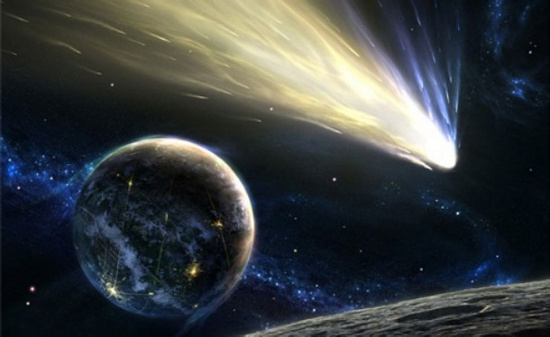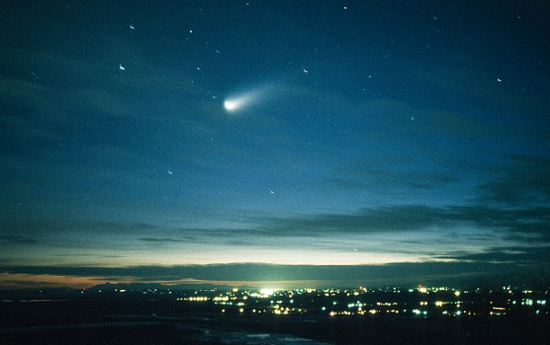Comet is brighter than the full moon visiting Earth in 2013
The giant comet was discovered by two Russian astronomers who will "drop by" the earth in 2013, with the glow that every human life can only be seen once.
Not only is the most astounding astronomical phenomenon in 2013, the comet phenomenon is brighter than the full moon, which also has the meaning of a century and hundreds of years of occurrence. At this point, the comet is quite faint, only visible with the most sophisticated telescopes. It moves slowly compared to the background stars.

Simulate a giant comet when stopping by Earth.
Observing on a telescope, the comet size is not too huge. However, it is moving straight towards us from deep space so it is difficult to accurately determine the size of the star. However, soon, the comet will be the main discussion topic of astronomers and scientific lovers around the world, when the time comes to approach the earth.
Named Comet Ison , comets can create millions of light trails in dark spaces, giving humanity the opportunity to witness one of the most astounding astronomical phenomena. Scientists say the light from Comet Ison when it flies over the globe is brighter than the full moon.
Although extremely unique, Comet Ison was only discovered not long ago thanks to the image of the night sky at the Kislovodsk observatory in Russia. Vitali Nevski and Artyom Novichonok, 2 astronomers discovered Comet Ison is working on a project to find comets and asteroids hovering in space.
Initially, two Russian astronomers could not identify the object they discovered as an asteroid or a comet. However, it is brighter than the surrounding objects and moves quite slowly, making Vitali Nevski and Artyom Novichonok focus. After using the larger telescope to monitor, they suddenly discovered it was a comet and named it Comet Ison.

The image of comet Hale-Bopp appeared in the sky of Alaska state (USA) in 1997
In fact, Ison takes millions of years to move to where humans can observe. It comes from the so-called Oort cloud , a reservoir of billions of stones and ice, left over from the process of regenerating planets. Oort cloud is located more than 4 light years away from the nearest planet.
The sun-like star also exists inside the Oort cloud, but the gravitational force it produces is sufficient to sustain the existence of this entire mass. Regardless of any small impact force, including the attraction of asteroids, it is possible to remove ice and ice from Oort, creating comets that roam the space.
Comet Ison is one of such comets. Scientists believe that Comet Ison's surface is even thicker than the asphalt, filled with dust and ice. The size of the comet is quite small, equivalent to a few tens of kilometers with extremely weak gravity. If humans make a jump from Comet Ison's surface, we can move over a distance of 32km and it takes more than a week to land back on the comet surface.
The timetable is clearly outlined in the process of Comet Ison visiting the earth. Accordingly, at the end of the summer, we can see Comet Ison through a personal telescope or binoculars. By October, Comet Ison would pass through Jupiter and begin to form a tail due to the comet surface being scorched by the sun, creating a thermal reaction that caused the comet crust to crack and evaporate ice.

Comet Ison comet flew over the earth.
By the time Comet Ison flew over the earth, steam and dust escaping from the comet surface would gather in the space around it, reflecting the sunshine and becoming brilliant. At this time, the huge mass of gas surrounding Comet Ison will grow to hundreds of kilometers, moving in a spiral from outside to inside, making the amount of light it reflects extremely large.
At the end of November, we can see Comet Ison with our eyes right after dark, with the sun setting. Its tail is like a lamp that illuminates the horizon. After stopping by the earth, Comet Ison will continue to travel by great attraction from the surface of the sun. It will orbit the sun at a distance of 3,200,000 kilometers, more than any other planet has ever done. After leaving the gravity of the sun, Comet Ison will continue the journey and never return to the solar system.
Notably, Ison is not the only spectacular comet next year. A comet called 2014 L4 (PanSTARRS), discovered last year will also be one of the spectacular astronomical phenomena of 2013. In terms of astronomy, 2013 deserves to be considered the year of the stars. Big broom.
- Full Moon facts - Full moon you may not know yet
- 'Super moon' is about to appear
- Snow moon, eclipse and comet - all will appear together this weekend
- Interesting things few people know about the Moon
- If your eyes are sharp, you'll see that the Moon is brighter than the Sun.
- Why is the Mid-Autumn Moon bigger and redder?
- Watching great comets shine brightly in the sky for 18 months
- Never see the full Moon from Earth
- Tonight the smallest full moon of the year
- Blue moon and Mars together illuminate tomorrow night sky
- On November 14, the largest super moon in 70 years will appear
- McNaught - the brightest comet in the past 30 years
 Van Allen's belt and evidence that the Apollo 11 mission to the Moon was myth
Van Allen's belt and evidence that the Apollo 11 mission to the Moon was myth The levels of civilization in the universe (Kardashev scale)
The levels of civilization in the universe (Kardashev scale) Today Mars, the sun and the Earth are aligned
Today Mars, the sun and the Earth are aligned The Amazon owner announced a secret plan to build a space base for thousands of people
The Amazon owner announced a secret plan to build a space base for thousands of people